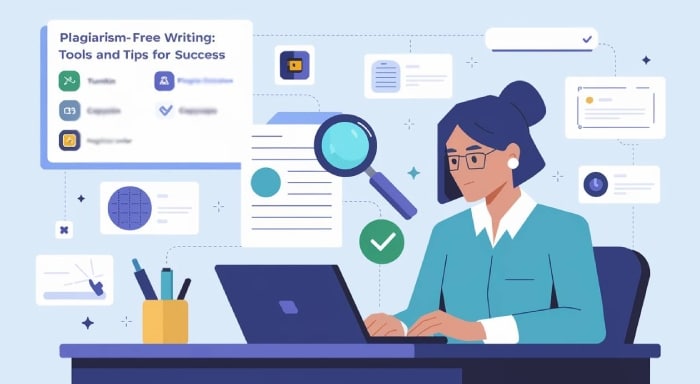Writing is an important skill that is relevant in the field of education ranging from school to college, where students continuously work on research papers, assignments, and essays. However, making sure that there is originality in writing can be a tricky process, especially when we are managing multiple tasks, complex topics, and deadlines. Plagiarism can have a damaging effect on your academics resulting in penalties, poor grades, and even expulsion. That is why it is significant to understand how to prevent this and inculcate robust writing habits.
To students’ advantage, there are numerous techniques and platforms available that help students ensure total originality in their content. By using a free plagiarism checker, students can ensure their writing is unique and free from accidental duplication. In addition, having knowledge about vital citation methods, enhancing research techniques, and creating a proper writing process can significantly minimize the possibilities of plagiarism.
This article covers the best tools for checking plagiarism and offers important tips that allow students to write well with total integrity. Irrespective of whether you are writing for homework, essays, or research papers, the below-mentioned strategies enable you to create high-quality and plagiarism-free content. Let’s get into the important methods and platforms that can make writing more effective and free from plagiarism.
Why Plagiarism Is a Critical Problem in the Field of Education?
What Is Plagiarism?
Plagiarism is detected when a student copies the work of someone else without any attribution or acknowledgment. Plagiarism can be accidental or intentional, but in both scenarios, it can lead to serious consequences. Whether paraphrasing a source without citing it or submitting another person’s work as your own, plagiarism damages credibility and academic integrity.
In educational institutions like colleges and schools, plagiarism is taken quite seriously and institutions must utilize advanced tools to identify copied content. Students must be aware of the fact that even small percentage of plagiarism can lead to loss of scholarships, grades, and even disciplinary actions. Knowing how to develop original content is not just related to reducing penalties but also about developing robust writing skills that will be advantageous to students in both their professional and academic careers.
Types of Plagiarism
There are many forms of plagiarism as discussed in the following sections:
- Direct Plagiarism – Directly copying the work of someone else word-by-word without any attribution.
- Self-Plagiarism – Reusing one’s previous assignments without permission.
- Patchwork Plagiarism – Combining phrases or ideas from different sources without proper citations.
- Accidental Plagiarism – Forgetting to cite sources correctly, leading to unintentional duplication.
Comprehending such types of plagiarism can allow students to identify and prevent instances of plagiarism in their writing.
Top Tools for Plagiarism-Free Writing
1. Plagiarism Checkers
Using plagiarism-checking tools is one of the most effective ways to ensure originality in school and college assignments. These platforms scan documents against large databases to find out whether there are any similarities. Some of the best options include:
- Grammarly Plagiarism Checker – Checks for duplicate content and suggests corrections.
- EssayPro – Widely used in schools and colleges to verify the originality of student submissions.
- Quetext – Offers deep scanning technology to detect hidden similarities.
- Duplichecker – A free option that allows quick checks for copied content.
By completing all the assignments with the help of these platforms, students can recognize and resolve plagiarism before submitting their work.
2. Citation and Referencing Tools
Including all the citations is vital to reduce plagiarism. Citation platforms allow students to create proper references in numerous formats like Chicago, APA, and MLA. Some helpful citation generators include:
- Cite This For Me – Automatically formats citations in multiple styles.
- Zotero – A research tool that helps with citation management.
- EasyBib – Generates citations for books, articles, and websites.
Leveraging these platforms makes sure that all the content sources are referenced properly, minimizing the risk of plagiarism.
3. Paraphrasing Tools
Paraphrasing tools help students rewrite content in their own words while maintaining the original meaning. Some useful tools include:
- QuillBot – An AI-powered paraphrasing tool that improves readability.
- EssayPro – A simple tool for rewording text.
- Spinbot – Helps rewrite sentences while keeping content unique.
Although paraphrasing tools can be useful, students should always review and refine the content to maintain accuracy and coherence.
Tips for Writing Plagiarism-Free Assignments
1. Improve Your Research Skills
Conducting thorough research is the foundation of original writing. Explore these tips to improve the process of research:
- Use multiple sources to gather information.
- Take notes in your own words rather than copying directly.
- Keep track of all references for proper citation.
By imbibing strong skills for research, students can create original content based on comprehension of the topic.
2. Develop Strong Writing Habits
Good writing habits help prevent plagiarism and improve overall writing quality. Here are some useful techniques:
- Plan your work – Create an outline before writing to organize your thoughts.
- Write in your own words – Summarize key points in a way that reflects your understanding.
- Edit and revise – Review your work to eliminate unintentional similarities with sources.
Consistently implementing these habits can considerably enhance the originality and bring more clarity in assignments.
3. Use Proper Citation Methods
Citing sources correctly is essential in academic writing. Different subjects and schools use different citation styles, such as:
- APA (American Psychological Association) – Common in psychology and social sciences.
- MLA (Modern Language Association) – Used in humanities and literature studies.
- Chicago Style – Preferred in history and some business subjects.
Students should familiarize themselves with the required citation style for their coursework to ensure compliance.
4. Check Your Work Before Submission
Before submitting assignments, students should:
- Run a plagiarism check using reliable tools.
- Proofread more to resolve errors and enhance clarity.
- Ensure all sources are properly cited.
Taking all these steps can reduce plagiarism and improve the overall quality of the final draft.
Conclusion
Writing plagiarism-free content is a vital skill set for students working in colleges and schools. By exploring a few plagiarism-detection platforms, upgrading methods for research, and developing good habits for writing, students can make sure that the assignments are original and structured well. Knowing how to cite sources properly and learning the skill of paraphrasing is an important skill that will enable you to maintain plagiarism-free content, improve methods for research, and develop good habits for writing. All these aspects play a vital role in making sure that the assignments are unique and well-structured. Learning to correctly cite sources and effectively paraphrase will enable you to maintain total integrity in academics.
If you ever struggle with writing or need additional help, always seek guidance from teachers, tutors, or online resources. Developing writing skill sets is not only important for academic performance but it is also essential for creativity and critical thinking–soft skills that prove to be extremely important beyond classroom.



